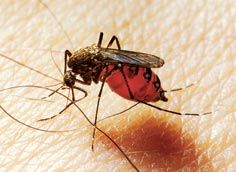GC–MS Detects Chemical Cue for Mosquitoes in Soil
Cedrol, a sequisterpene alcohol found in the essential oil of connifers, could be a potent chemical cue for pregnant mosquitoes seeking the ideal location to lay their eggs. The compound was identified in a study looking at how mosquitoes find the ideal water body to lay their eggs. According to the study published in the Malaria Journal, cedrol could be used in the development of “attract and kill” traps targeting pregnant mosquitoes and reducing the spread of malaria.
Photo Credit: Renaud Visage/Getty Images

Cedrol, a sequisterpene alcohol found in the essential oil of connifers, could be a potent chemical cue for pregnant mosquitoes seeking the ideal location to lay their eggs. The compound was identified in a study looking at how mosquitoes find the ideal water body to lay their eggs. According to the study published in the Malaria Journal, cedrol could be used in the development of “attract and kill” traps targeting pregnant mosquitoes and reducing the spread of malaria.1
Malaria is a serious disease that affects populations worldwide - the World Health Organization (WHO) estimate that it is responsible for the death of one child every minute in the Africa region. The disease itself is caused by the Plasmodium parasite, which is transmitted by the saliva of infected mosquitoes injected into the bloodstream to prevent clotting when feeding on an animal or human host. Strategies aimed at reducing the spread of malaria have been dependent on preventing mosquitoes finding a host with the use of insecticides or physical barriers (nets), but insecticide resistance is on the rise and physical barriers are not always effective.
The OviART research group - an international team of researchers from the Kenya-based International Centre of Insect Physiology and Ecology, the London School of Hygiene and Tropical Medicine, the Swedish Royal Institute of Technology, and Durham University - has been studying the behaviour of malaria carrying mosquitoes for over six years to find out what happens after a mosquito has taken a blood meal, and how the pregnant female chooses a location for egg laying.
The study began with the observation that Anopheles spp. larvae were found in some water bodies near to Lake Victoria (Kenya), but not all, even though all contained water from the lake. Corresponding author Michael N. Okal told The Column: “My colleagues and I investigated biological, physical, and chemical factors that could define those [water bodies] with high densities of larvae. In time we narrowed down to the soil from such breeding sites when we found that mosquitoes in the lab liked laying eggs in water pre-mixed with it.”
The team trapped volatile organic compounds from lake water samples, lake water infused with soil from a known mosquito-breeding site, and soil-infused lake water samples that had been autoclaved. In parallel, bioassays showed that the unmodified soil-infused lake water elicited a stronger response than just lake water or autoclaved soil infusions suggesting the presence of attractive chemical compounds in the soil, which were identified by performing gas chromatography–mass spectrometry (GC–MS) analysis. The researchers then collected 116 water samples from locations in the study area - including puddles, ponds, and pools - and found the widespread distribution of cedrol in the area. Traps baited with cedrol were three times more likely to attract pregnant mosquitoes than with water alone. 1
According to Okal, there were significant challenges that were overcome in the study. He said: “Just to mention a few: Very early in our study we realized that common experiments used with mosquitoes were unfit for Anopheles gambiae because of peculiarities in their egg laying habits. Then we found out that in order to detect the very low concentrations of odourants emitted from water bodies we needed to work on better ways of dealing with our samples. These might be part of the reason many such studies have failed before. However, thanks to a well-coordinated multi-disciplinary team put together by Dr. Ulrike Fillinger we were able to overcome this and identify cedrol.”
Although cedrol appears to be a promising tool in the control of malaria mosquitoes, Okal told The Column that there is still a lot of uncertainty. “The identification of cedrol is only the beginning of this. To use this, we will need, among other things, better mosquito traps and innovative ways of using cedrol. We then need to do larger scale field studies to evaluate the effectiveness of the attract-and-kill strategy. This is a challenging process that could take anything from a few to many years. As mosquito ecologists we know that there could be other factors and chemicals still undefined that could attract mosquitoes to choice water bodies. We will work together with other experts in the field to develop this further.” - B.D.
Reference
1. J.M. Lindh et al., Malaria Journal14(119) DOI: 10.1186/s12936-015-0636-0 (2015).

Characterizing Plant Polysaccharides Using Size-Exclusion Chromatography
April 4th 2025With green chemistry becoming more standardized, Leena Pitkänen of Aalto University analyzed how useful size-exclusion chromatography (SEC) and asymmetric flow field-flow fractionation (AF4) could be in characterizing plant polysaccharides.
Investigating the Protective Effects of Frankincense Oil on Wound Healing with GC–MS
April 2nd 2025Frankincense essential oil is known for its anti-inflammatory, antioxidant, and therapeutic properties. A recent study investigated the protective effects of the oil in an excision wound model in rats, focusing on oxidative stress reduction, inflammatory cytokine modulation, and caspase-3 regulation; chemical composition of the oil was analyzed using gas chromatography–mass spectrometry (GC–MS).









